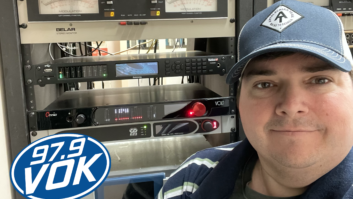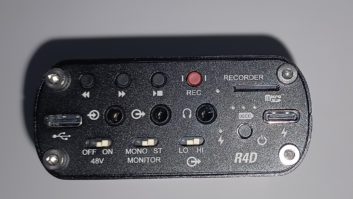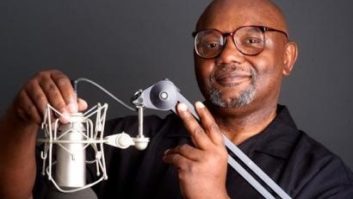Side by Side: Headset Mics
Aug 1, 2013 7:23 AM, By Chriss Scherer, editor
The prime use of headset mics is likely for coverage of sporting events. With typically so much ambient noise and the announcers constantly moving, the headset provides the isolation needed to monitor the broadcast while the fixed mic location ensures consistent audio pickup. But these advantages can be beneficial when covering other events, such as a political convention, major news event or even a remote from a large venue.
We looked for models that offered circumaural earpieces. By covering the ear, there is greater isolation from outside noise. We also liked headsets that allowed the mic boom to be placed at either side of the announcer’s mouth. Doing this will reverse the left and right earpieces, so a stereo image will be reversed. If that’s a problem, add a channel reverse adapter to the remote kit.
The types of mic pickup are flavors of a cardioid pattern. A classic cardioid has the best rear rejection, but the sides still have good pickup. As the patterns move to super- and hypercardioid, more rear pickup creeps in as the side pickup is reduced. You may need to experiment with various patterns to decide which works best for your application.
Some models feature a muting function when the mic boom is moved to the top of the set or removed from the user’s head. This may come in handy in some uses.
Take note of the connectors when buying a headset. Some break out to XLR and TRS, while others use a 4- or 5-pin XLR. Others may have no connectors at all.

AKG HSD171
This closed, on-ear studio headset provides high noise isolation for loud environments. The headset combines the K171 MKII studio headphones with a rugged dynamic microphone. The flexible microphone arm mutes the microphone automatically as it is moved up. The headset also has a switch in the headband that mutes the audio when the headphones are taken off. The cable connects to the headphones via a six-pin mini XLR connector. Also available is the HSC171, which features a condenser mic.
Headphones: 18Hz to 26kHz, 55?
Mic: 60Hz to 17kHz, hypercardioid, 600?
akg.com

Audio-Technica BPHS1
This rugged headset features closed-back around-the-ear ear to provide maximum comfort and ambient noise rejection. Neodynium magnets are used in the mic and headphone for higher output. The headset has a boom-mounted, dynamic microphone that can be positioned for use on either side of the mouth. The 3.3m detachable cable is terminated in a 3-pin XLR and 1/4″ TRS for the mic and headphone. It includes three mic windscreens and a spare connector screw.
Headphones: 20Hz to 20kHz, 65?
Mic: 40Hz to 20kHz, cardioid, 560?
audio-technica.com

Beyer Dynamic DT 790
This headset combines the classic closed-design DT 770 PRO with the addition of a pivoting gooseneck microphone boom with a dynamic DT 290 element. Neutrik connectors are used throughout. The 1.5m cable has a 4-pin XLR or no connector to install your own. The microphone boom can be used at left or right side or can be moved into standby (upper) position. An optional limiter can be ordered to protect a user’s hearing during use. The threshold is specified when the headset is ordered. The DT 797 with a condenser cardioid microphone is also available.
Headphones: 5Hz to 30kHz, 80?
Mic: 40Hz to 12kHz, hypercardioid, 200?
beyerdynamic-usa.com

Sennheiser HMD280 Pro
The lightweight, ergonomic headphone attenuates ambient noise by 32dB via a closed-back, circumaural design is paired with a super-cardioid dynamic microphone mounted on a flexible, acoustically isolated boom. A single, coiled (1m to 3m) cable carries monitoring and talkback signals. The cable is attached, but can be replaced in the field. The microphone boom can be rotated for use from either side of the mouth. The entire assembly collapses for transport. It includes a wind/pop filter.
Headphones: 8Hz to 25kHz, 64? (300? optional)
Mic: 50Hz to 13.5kHz, supercardioid, 200?
sennheiserusa.com

Shure BRH440M
This closed-back, circumaural headset with neodymium magnets offers sound isolation from background noise. The dynamic cardioid microphone is mounted on a boom that pivots 270 degrees for left or right side wear. A flip-up mute function deactivates the boom microphone when it is raised vertically away from the mouth. The single-side, detachable cable is unterminated to allow the user to attach his own connectors. The user-replaceable cable, ear pads and windscreen are included.
Headphones: 15Hz to 27kHz, 300?
Mic: 50Hz to 15kHz, cardioid, 200?
shure.com
August 2013
Audio over IP update, Clear Channel in Gadsden, AL, what COPPA means to your station, headset mics, and a final look at the first year of Radio magazine….












